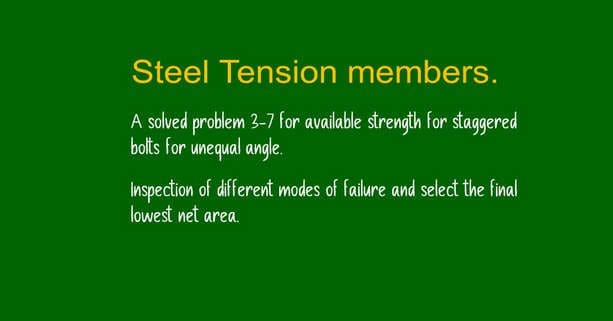Last Updated on April 29, 2024 by Maged kamel
Problem 3-7 for staggered bolts-tension members.
Brief description of problem 3-7 for staggered bolts.
We will review the solved problem 3-7 for staggered bolts-tension members. This problem is quoted from Prof. Segui’s handbook. The main aim is to investigate the different failure routes of failures and the corresponding net areas.
Prof. Segui has taken into consideration the actual force acting on each net area and adjusted the estimated net area, as we will see in the next calculations
.
An angle of 6x8x1/2 has four bolt lines. Two lines are on the short leg, and the other two are on the long leg.
The bolt’s diameter is 7/8 inches, and the steel used is A36 steel. The LRFD design strength for the bolted angle and the ASD design strength of the same angle must be found. For more clarity, please open the image in a separate link.
The image shows the arrangement of the bolt lines when the angle is unfolded to become a plate. The overall height of the unfolded plate is 13.50 inches. The height from the second and third grids is 4 3/4 inches.
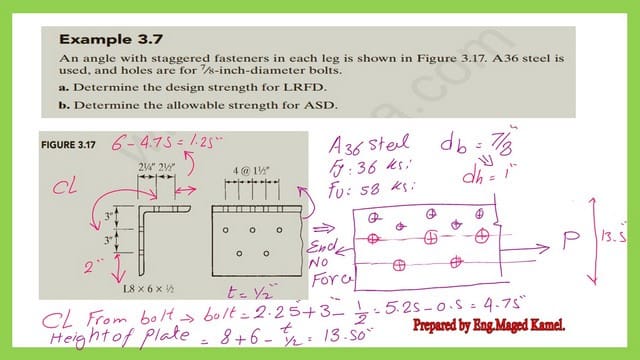
The next slide image shows the different grids for the angle and spacing between bolts and how we check that the overall height matches the added vertical distances between bolts.
The Force P is transferred through bolts to the other connected plate; each bolt will receive a part of that load, which equals the total load divided by the number of bolts. We have ten bolts, so each bolt will transfer a value of P/10
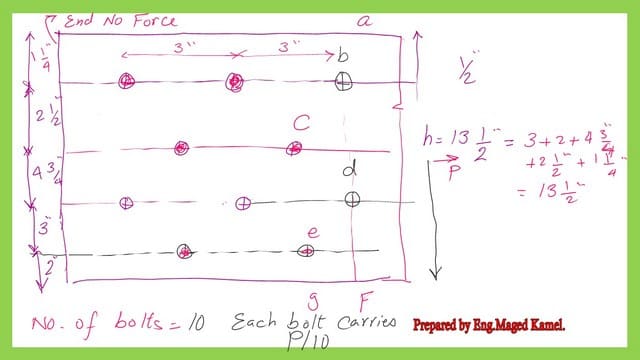
Investigate the first route abcf.
The bolt’s diameter is 7/8 inches, and we will add an additional 1/8 inch to account for damage and bunching. The hole diameter will be equal to 1 inch.
The area of the unequal angle 6x8x1/2 is equal to 6.80 inches obtained from the table of angles and that area will be set equal to the gross area of the angle.
For route abcf, the gross area is deducted by two hole areas, which equals 1.0 inch2, with no staggered distances.
The net area can be estimated as equal to (6.80-1.00)=5.80 inch2. There is no bolt on the right side of the section; the section carries 100% of the load P.

.
Investigate the second route abcdf.
For route abcdf, the gross area is deducted by three hole areas, which equals 1.50 inch2; there are two staggered distances. We will add the sum of S^2/4g*t to account for the added area. The s distance equals 1.50 inches while we have two different g values; the first g equals 2.50 inches while the second g distance equals 4.75 inches. The sum of S^2/4g*t equals 0.349 inch2. The net area of that route equals 6.8-1.50+0.349=5.649 inch2
The route’s net area is not adjusted since the acting force in the section is 100% P, as shown in the next slide image.
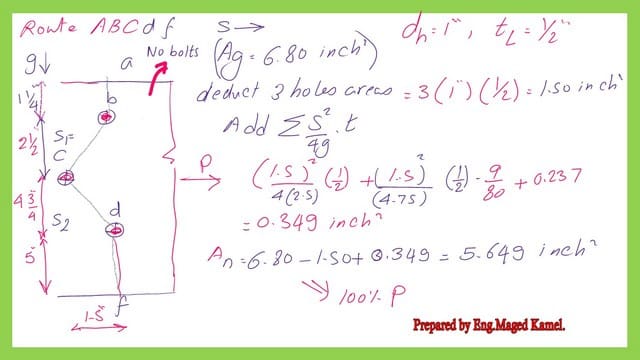
Investigate the third route abcdeg.
For route abcdeg, the gross area is deducted by four hole areas, which equals 2.0 inch2, and three staggered distances exist. We will add the sum of S^2/4g*t to account for the added area.
The s distance equals 1.50 inches while we have three different values of g, the first g equals 2.50 inches while the second g distance equals 4.75 inches, and the last gauge line distance equals 3 inches.
The sum of S^2/4g*t equals 0.265 inch2. The net area of that route equals 6.8-2.0+0.265=5.65 inch2
The route’s net area is not adjusted since the acting force in the section is 100% P, as shown in the next slide image.

Investigate the fourth route acdeg
For route acdeg, the gross area is deducted by three hole areas, which equals 1.50 inch2, and two staggered distances exist. We will add the sum of S^2/4g*t to account for the added area.
The s distance equals 1.50 inches while we have two different values of g, the first g equals 4.75 inches while the second g distance equals 3.0 inches.
The sum of S^2/4g*t equals 0.153 inch2. The net area of that route equals 6.8-1.50+0.153=5.65 inch2
The route’s net area is to be adjusted. One bolt at the right side of the section transfers a P/10 load. The acting force in the section is 90% P, as shown in the next slide image. The adjusted net area will be equal to 6.059 inch2.
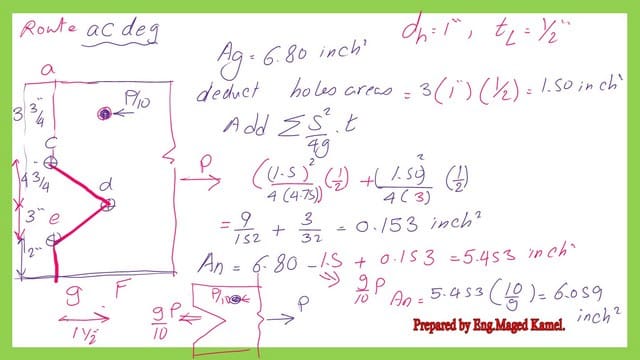
Investigate the last route acdeg.
For the last route acdeg, two hole areas to be deducted. The net area equals 5.80inch2; there are no staggered lines. The net area is to be adjusted; two bolts are on the right side of the sections. The estimated area to be multiplied by 10/8 to account for 100% P of the load. The final net area equals 9.06 inch2.

What is the least net area for problem 3-7 for staggered bolts?
The least value of the net area is 5.065 inch^2 and belongs to the final route. abcdeg. The effective area for the lowest value of the net area can be estimated by multiplying U by the Anet.
The U value equals one since the angle is connected for all the legs. The LRFD design strength equals 220 kips; please refer to the next slide for more details about the estimation.
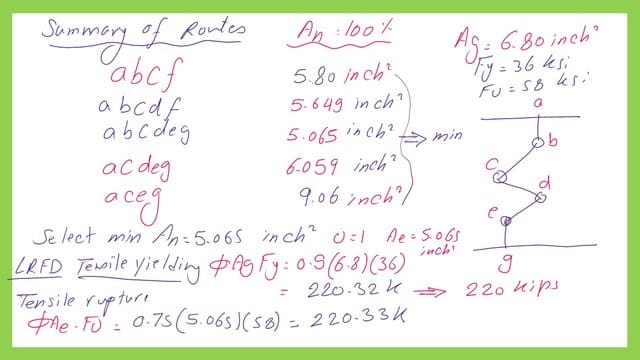
The lowest value of the net area is 5.065 inch^2 and belongs to the final route. abcdeg. The effective area for the lowest value of the net area can be estimated by multiplying U by the Anet.
The U value equals one since the angle is connected for all the legs. The ASD design allowable strength equals 147 kips; please refer to the next slide for more details about the estimation.
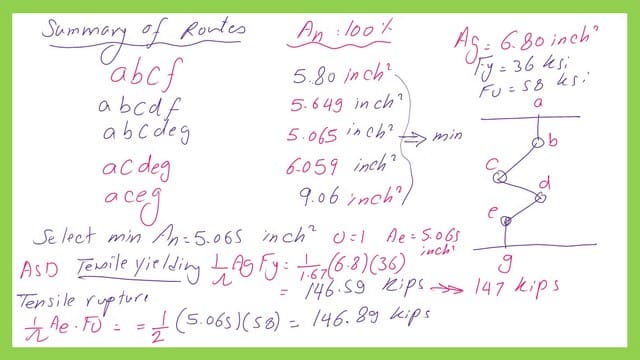
A link to the previous post solved 5-7 for block shear.
The next post is Problem 3-4-3 for staggered bolts-tension members-1/2.
There is a very useful external link- Block Shear Rupture for a more detailed illustration of block shear. A Beginner’s Guide to the Steel Construction Manual, 14th ed.
